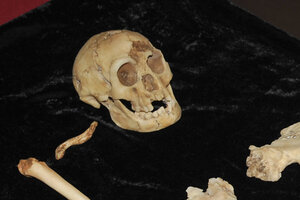New study says hobbit-like beings colonized island 1 million years ago
Researchers say ancestors of hobbit-like humans may have colonized an Indonesian island one million years ago.

A 3D cast of a controversial skeleton called the "Hobbit" known as Homo Floresiensis is revealed at Stoney Brook, State University of New York. The original skeleton which is only 18,000 years old was discovered on the Island of Flores in Indonesia in 2003.
NEWSCOM/FILE
Hong Kong
Ancestors of a hobbit-like species of humans may have colonized the Indonesian island of Flores as far back as a million years ago, much earlier than thought, according to a new study published Thursday.
These early ancestors, or hominins, were previously thought to have arrived on the island about 800,000 years ago but artifacts found in a new archaeological site suggest they might have been around even earlier.
In a paper published in Nature, researchers said their findings suggest these hominins may have evolved into tiny hobbit-like humans, or "Flores man," who stood about a meter tall and had skulls the size of grapefruit.
Skeletal remains of an 18,000-year-old "Flores man" were discovered about five years ago and scientists then determined it belonged to a species of human completely new to science.
Named Homo floresiensis, after the island on which it was found, the tiny human has also been dubbed "hobbit," after the tiny creatures from the "Lord of the Rings."
The arrival of hominins is also believed to have resulted quickly in the mass death of giant tortoises and the Stegondon sondaari, a pygmy elephant, on the island.In their paper, the researchers said they found 45 stone tools in Wolo Sege in the Soa basin in Flores.
Led by Adam Brumm at the Center of Archaeological Science in the University of Wollongong in New South Wales, Australia, the researchers used new dating methods and found that the stone tools were about a million years old.
"It is now clear, however, in light of the evidence from Wolo Sege, that hominins were present on Flores (a million years ago). This suggests that the non-selective, mass death of Stegondon sondaari and giant tortoise ... could represent a localized or regional extinction," they wrote in their paper."Flores man" is thought to be a descendant of homo erectus, who had a large brain, was full-sized and spread out from Africa to Asia about two million years ago.
Scientists suspect "Flores man" lived at the same time as modern humans and became extinct after a massive volcanic eruption on the island around 12,000 years ago.
From the archives: Fossils of tiny people further theory of co-existing humanoids
